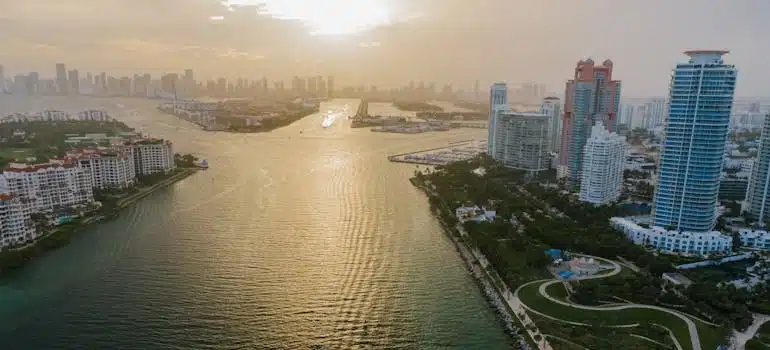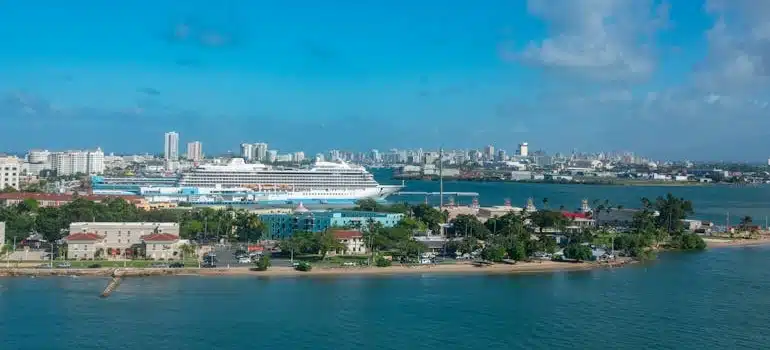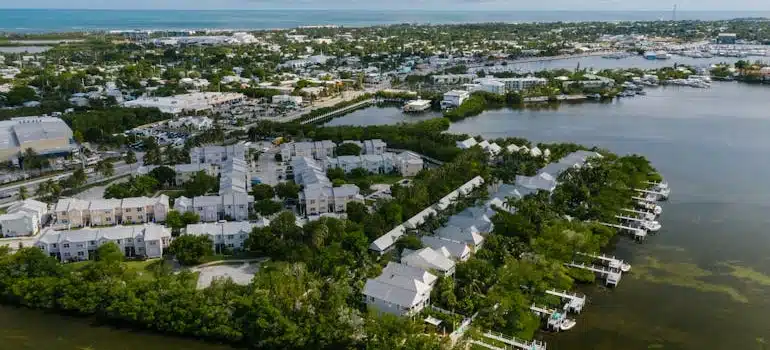Best Florida island communities
Florida is home to many sought-after islands that attract both buyers and renters. The best Florida island communities offer scenic coastlines, diverse housing, and easy access to larger cities. Some feature high-rise condos with walkable neighborhoods, while others are quieter areas with luxury estates. Choosing the right island involves comparing housing prices, insurance costs, commute options, and local services. This article by the best moving companies in Florida explores leading Florida island communities, outlining lifestyle benefits and practical details so you can better evaluate which location fits your needs.
How to choose an island community
Selecting among the best Florida island communities requires more than liking a beach view. Each island comes with different housing options, rules, and daily realities. One of the first points to review is access. Some islands are connected by several causeways, while others depend on a single bridge or even a ferry. This factor affects commutes, delivery schedules, and evacuation during storms.
Housing supply is another key difference. Miami Beach and Sunny Isles Beach offer mostly condos, while Hibiscus Island and Indian Creek feature single-family waterfront estates. Prices also vary widely depending on location, amenities, and proximity to the mainland.
Here are a few main factors to consider when comparing Florida island communities:
- Commute times and bridge or ferry access
- Average housing costs and HOA fees
- Insurance premiums tied to flood and wind zones
- Rental rules, especially for condos
- Availability of schools, hospitals, and shopping
Insurance can heavily influence overall affordability. Many island homes are located in high-risk flood zones, including Miami-Dade, resulting in policies that can cost several thousand dollars per year. Homes built after updated codes, with reinforced roofs or hurricane shutters, often qualify for discounts.

Everyday services also play a big role. Relocations into these areas are often smoother with the help of moving companies in Miami-Dade who understand local bridge access, HOA rules, and island delivery restrictions. Larger islands have full grocery stores, clinics, and schools. Smaller ones may require frequent trips to the mainland. Internet reliability and cell service are crucial for remote workers, making infrastructure checks an integral part of the decision-making process.
Sanibel and Captiva
Sanibel and Captiva Islands, located off Florida’s Gulf Coast, are prized for their natural setting. They are famous for shell-covered beaches, bike trails, and wildlife refuges.
Housing ranges from $800,000 for smaller homes to more than $3 million for waterfront estates. After Hurricane Ian, rebuilding efforts have raised construction standards and insurance costs. Flood and wind policies often exceed $10,000 annually for single-family homes near the water.
These islands attract retirees, second-home buyers, and nature lovers who value peace over urban convenience. However, job opportunities are limited, and access to major hospitals or airports requires long drives. Sanibel and Captiva are best suited for those who want quiet, seasonal living rather than full-time urban access.
South Beach
South Beach is one of the most recognized neighborhoods in Florida. It stretches from South Pointe Park up to around 23rd Street. The area is known for nightlife, dining, and Art Deco architecture.
Housing is dominated by condos. Entry-level units may start around $500,000, but luxury penthouses often exceed $10 million. The mix attracts both investors and seasonal residents.
Walkability is a major benefit. Most errands can be done on foot, though parking is scarce. HOA fees vary depending on the building, but often include security, pools, and fitness centers. Insurance costs range from $3,500 to $8,000 annually, depending on unit size and elevation.
South Beach suits professionals, international buyers, and those wanting entertainment at their doorstep. And many of those new residents use movers in South Beach, FL, to handle condo moving permits, parking challenges, and delivery timing.
Marco Island
Marco Island, in Collier County, is a Gulf Coast community that draws retirees and second-home buyers. It’s more remote than Miami-area islands, with Naples being the nearest city hub.
Housing includes a mix of waterfront condos and single-family homes along canals. Prices often run between $600,000 and $3 million. The island has wide beaches and seasonal tourism, leading to high demand during the winter months.
While appealing to those who want a master-planned feel, Marco Island can feel disconnected for commuters or younger families. Insurance costs are similar to other Gulf islands, with flood and wind coverage adding several thousand dollars per year. It remains a strong option for those prioritizing peace over big-city access.
Fisher Island
Fisher Island is among the most exclusive islands in the country. Accessible only by private ferry, yacht, or helicopter, it appeals to high-net-worth residents seeking privacy.
Condos dominate the housing market, with average sales often exceeding $3 million. Amenities include private beaches, marinas, golf, tennis, and a members-only club. Limited public access helps maintain privacy, but it also means residents rely on the ferry for most daily services.
Insurance costs reflect high-value properties, with premiums climbing based on waterfront exposure. Fisher Island works best for those who prioritize exclusivity and security over convenience. Since all deliveries and moves must coordinate with the private ferry, most newcomers hire movers in Fisher Island, FL, familiar with the access process.
Indian Creek Island
Indian Creek is another ultra-luxury community, sometimes called the “Billionaire Bunker.” It features just over 40 homes, all waterfront estates, and a private golf course. Security is tight, with its own police force.
Home prices regularly exceed $20 million, making it one of the most expensive places to live in Florida. Insurance and maintenance costs are high, but these owners usually view them as secondary to privacy and status.
Daily life requires trips to nearby Bay Harbor or Miami Beach for shopping and school. Indian Creek suits buyers who want maximum privacy with immediate access to Miami-Dade amenities. Relocating here often requires movers in Indian Creek Island who can manage gated entry rules and high-value property handling.

Key Biscayne
Key Biscayne is one of the best Florida island communities for families who want a suburban feel close to Miami. It connects to the mainland by the Rickenbacker Causeway, making commutes into Brickell and Downtown Miami possible in 20–40 minutes, depending on traffic.
The island has strong schools, including Key Biscayne K–8 and private academies. Families also enjoy Crandon Park and Bill Baggs Cape Florida State Park, both popular for biking and water sports.
Housing costs remain high. Condos often start around $900,000, while single-family homes typically exceed $3 million. Insurance averages $4,000–$8,000 annually due to flood risk. Residents value the balance between city access and a quieter, community-oriented lifestyle.
North Beach
North Beach sits at the northern end of Miami Beach. It is quieter than South Beach and more affordable. Families often prefer this area because of parks, schools, and wider streets.
Condo prices begin around $400,000, while larger waterfront properties can exceed $2 million. New developments have focused on mid-rise condos with modern amenities. Compared to South Beach, HOA fees are lower, and insurance premiums average $2,500–$6,000 per year.
North Beach offers easier parking and less traffic. Public transport via buses and trolleys connects the area to other parts of Miami Beach. The community appeals to full-time residents who want proximity to Miami without the intensity of South Beach. Moving here is simpler with movers in North Miami Beach, who handle condo approvals and parking restrictions.
Aventura Islands
The Aventura area includes Williams Island, Privé Island, and other smaller island communities. These are popular with professionals, retirees, and international buyers who want luxury condos with marina access. Condos typically range from $700,000 to $3 million. Monthly HOA fees can be high, often $1,500–$3,000, but they include amenities such as pools, gyms, security, and in some cases, private clubs.
Insurance premiums average $3,000–$7,000 annually, depending on elevation and building updates. The community offers easy access to Aventura Mall, healthcare centers, and schools. For boaters, private marinas are a major benefit.
Aventura Islands suit residents who want full amenities without the crowds of Miami Beach. Moves into these high-rise condos usually require coordination with HOAs, which is why many rely on movers in Aventura who know the area’s procedures.
Longboat Key
Longboat Key, near Sarasota, is a Gulf Coast island community with a quieter, country-club atmosphere. It attracts retirees and second-home owners.
Housing is a mix of condos and single-family homes. Prices generally start near $800,000, with luxury waterfront properties reaching $5 million or more. Insurance rates reflect exposure to Gulf storms, often averaging $4,500–$9,000 per year.
Longboat Key offers golf courses, marinas, and upscale dining, but limited nightlife. Services like major hospitals and international airports require a drive to Sarasota or Tampa. This makes Longboat Key appealing for those prioritizing relaxation over convenience.
Sunny Isles Beach
Sunny Isles Beach is lined with high-rise condo towers, giving it the nickname “Florida’s Riviera.” It attracts retirees, families, and international buyers who want direct beach access.
Condos here start around $700,000, but luxury penthouses often sell for $10 million or more. HOA fees are high, often $1,500–$3,500 per month, but they cover concierge services, gyms, pools, and private beach access. Insurance costs vary from $3,500–$7,500 annually, depending on the building’s storm rating. Sunny Isles also has parks, restaurants, and good schools nearby, which make it more versatile than purely tourist-oriented areas.
It is one of the most sought-after and best Florida island communities for those who prefer condo living with strong services. Condo relocations are best handled by movers in Sunny Isles Beach who are familiar with elevator bookings and building approvals.

Marathon
Marathon sits in the Middle Keys, about two hours south of Miami. It appeals to families and retirees who want a mix of small-town feel and easy water access. The island has schools, a hospital, and grocery stores, which makes it more practical for full-time living compared to smaller Keys communities.
Housing includes canal-front homes, condos, and new developments. Prices average $700,000–$1.5 million, with waterfront estates reaching higher. Insurance costs range from $4,000–$9,000 per year, reflecting the high flood and wind exposure.
Marathon is known for boating and fishing. It has marinas, public parks, and access to both the Atlantic and the Gulf. Seasonal tourism boosts the economy, but traffic along U.S. 1 can be a challenge during peak weekends.
For buyers wanting a balance of services and island lifestyle, Marathon remains one of the best Florida island communities. Relocations into the Keys are often managed by movers in Marathon, FL, who understand U.S. 1 traffic patterns and local access rules.
Cost snapshot: housing, insurance, and taxes
Living in the best Florida island communities requires planning for higher costs. Housing is the largest expense. Condos in Miami-area islands often start at $500,000, while luxury properties can exceed $10 million. Single-family homes on exclusive islands like Indian Creek regularly top $20 million.
Insurance adds another layer. Flood and wind policies are essential on barrier islands. Annual premiums range from $3,000 to $10,000 for most properties. Older homes or those without hurricane updates may pay more. Newer buildings with impact windows, reinforced roofs, and higher elevations may qualify for discounts.
Property taxes vary by county. Miami-Dade averages around 2% of assessed value, but the Florida Homestead Exemption can reduce taxes for primary residents. Buyers should factor these costs early, since housing, insurance, and taxes together shape long-term affordability.
Daily life checklist
Choosing among Florida’s island communities means evaluating more than home prices and views. Daily living needs often decide whether an island works long-term. Some areas provide full services, while others require frequent trips to the mainland. Here are the most important points to check:
- Schools: Key Biscayne, North Beach, and Aventura have local schools, while smaller islands may not.
- Healthcare: Marathon has a hospital; others depend on mainland facilities. Confirm urgent care options.
- Groceries: Larger islands host supermarkets, but Fisher Island and Indian Creek rely on delivery.
- Transportation: Check bridge access, ferry schedules, and rush-hour patterns for commutes.
- Internet reliability: Miami-area islands offer fiber; the Keys may have slower speeds.
- Emergency planning: Review evacuation routes, shelter access, and hurricane readiness.
- Parking and access: Condo-heavy areas like Sunny Isles and South Beach may have limited parking.
- Recreation: Some islands have parks, marinas, or golf, while others require mainland trips.
For remote workers, internet and power backup options can be as important as square footage. Families may prioritize schools and healthcare, while retirees might focus on recreation and daily convenience. Weighing these details ensures your chosen island fits not just vacation dreams but everyday life.
Moving and logistics tips for islands
Relocating to Florida’s islands comes with practical challenges. Condo buildings often require scheduling moves in advance, including elevator reservations and certificates of insurance for movers. Also, HOA rules may limit moving hours or truck sizes.
On gated islands such as Hibiscus, Palm, or Indian Creek, security clearance is required for moving crews. Fisher Island requires coordination with the private ferry for deliveries. In the Keys, moving schedules can be slowed by single-lane traffic on U.S. 1.
Packing also deserves attention. Hurricane-rated boxes and waterproof storage can protect belongings if storms strike during a move. Vehicle parking and delivery access are often limited on smaller islands, so confirm these details before hiring a moving company. Proper preparation avoids delays and added costs.

FAQs about living in Florida island communities
Before choosing among the best Florida island communities, many buyers and renters share similar concerns. These FAQs address the most common questions about daily life, costs, and moving logistics on Florida’s islands.
Q: Which islands are most family-friendly?
A: Key Biscayne, North Beach, and Marathon stand out with schools, parks, and local services suited for families.
Q: Where are the most exclusive estates?
A: Indian Creek, Fisher Island, and Hibiscus Island feature multimillion-dollar properties with strict security and privacy.
Q: Which FL island areas allow short-term rentals?
A: Some condos in Miami Beach permit short-term rentals, but many HOAs restrict or ban them. Always confirm before buying.
Q: Do hurricanes make island living too risky?
A: Storms are a reality, but modern codes, shutters, and insurance help reduce financial and safety risks.
Q: How high are insurance costs on Florida islands?
A: Flood and wind coverage often run $3,000–$10,000 annually. Homes built to newer codes may qualify for lower rates.
Q: Is commuting from the islands practical for work in Miami?
A: Key Biscayne, North Beach, and Aventura offer manageable commutes. The Keys require longer drives on U.S. 1.
Q: Are healthcare facilities on Florida islands easy to access?
A: Larger islands like Marathon and Key Biscayne have clinics or hospitals. Smaller islands rely on nearby mainland cities.
Q: What about groceries and daily errands?
A: Miami-area islands have supermarkets nearby. Fisher Island and Indian Creek depend on deliveries or quick trips to Miami.
Q: Can I live car-free on these islands?
A: South Beach and North Beach are walkable. Most others still require a car for errands and commuting.
Q: Which Florida islands are best for retirees?
A: Sunny Isles Beach, Aventura Islands, and Longboat Key attract retirees with condos, services, and leisure options.
Q: How do HOA rules affect moving in?
A: Many condo buildings require scheduling moves, reserving elevators, and providing certificates of insurance to movers.
